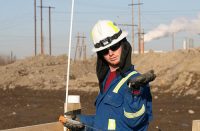AFTER THE PROVINCIAL GOVERNMENT CREATED THE ONTARIO GREENBELT IN 2005, an unforeseen land-buying frenzy began just beyond its borders. Developers, land bankers and their offshore investors have since bought up thousands of hectares of farmland in the counties of Brant, Simcoe, Niagara and Wellington.
AFTER THE PROVINCIAL GOVERNMENT CREATED THE ONTARIO GREENBELT IN 2005, an unforeseen land-buying frenzy began just beyond its borders. Developers, land bankers and their offshore investors have since bought up thousands of hectares of farmland in the counties of Brant, Simcoe, Niagara and Wellington.
Brant County is a thirty-minute drive west of Hamilton, and abuts the western border of the Ontario Greenbelt. In 1980 the Province of Ontario, City of Brantford and County of Brant set an example for other municipalities and created a ribbon of “permanent agricultural” land around the edge of Brantford. The north-eastern edge of this ribbon is one kilometer from the western border of the Ontario Greenbelt. It is difficult to understand why the Ontario Greenbelt does not include Brant and its green ribbon. Developers now argue that this “permanent agriculture” ribbon has expired.
Brant County is known as a breadbasket, one of the very best places in Canada to grow food. Yet Brant also serves as the “relief valve” for growth that is not permitted within the Ontario Greenbelt. Brant County is “the target of one of the most aggressive farmland grabs by offshore investors in the country,” according to Shiloh Bouvette of the Ontario Greenbelt Alliance. “Community members that I spoke with told me stories about elderly widows approached by land buying agents, one even at her husband’s funeral.”
By 2006, word had spread in the Brant County community that some farmers were becoming instant millionaires by selling their farms to a land banking company. Land banking involves the strategic purchase of huge tracts of land for future development, which typically allows the land banker to gain enough influence over municipalities to rezone foodland, and to influence provincial and municipal governments to build roads, sewers and water pipelines by virtue of their position as a dominant landowner. The rezoned land becomes much more valuable and is later resold at inflated prices, with the profits going to the investors.
In May 2007, Michael-Allan Marion of the Brantford Expositor wrote a three-day series called “The Great Land Rush.” He documented “an ongoing wave of farmland acquisitions led by such outside land bankers and developers as Walton International, Empire Communities, Hopewell Developments and First Urban, taking up at that point more than 7,000 acres [2,833 hectares] and counting.” Marion exposed “a coherent strategy by those who would have the county in their grip to buy as much land as possible one or two concessions away from the city’s [Brantford] boundaries and close to Paris and St. George.”
Walton International, a land banking company based in Calgary, Alberta, has purchased approximately six per cent of Brant County farmland, using money from offshore investors. Walton manages nearly 25,000 hectares of land in North America, more than 5,000 hectares of it located just outside of the greenbelts around Toronto and Ottawa.
The $3-billion company operates by buying farmland for inflated prices, then selling shares to investors (predominately from Malaysia, Hong Kong, and Singapore). These shareholders may have no idea of what they are investing in and how it affects the community where the investment physically exists. One small farm may have hundreds of shareholders
According to Walton’s literature, once farmland has been acquired, Walton works with local councils to enact changes to land use, annexation and zoning legislation. In Walton’s own literature, they make the statement “the key to success in this business is to become the dominant landowner in an area.” The company then sells its property to other owners or potential developers for a higher price, sometimes using its own subsidiaries as buyers so that they can also borrow more money. The initial cost of buying land is recouped and large profits are made through this syndication process.
In the Brant County neighbourhood of Tutela Heights, for example, Walton purchased a farm through 1664531 Ontario Inc. for $2.2-million in 2006, which it then transferred to Walton Tutela Heights Corporation and Walton Tutela Heights Ontario Limited Partnership. Four years later, the property was resold for $18-million to two other Walton subsidiaries, Riverbend Asset Management Corporation and Brant County Riverbend Development LP. This buying and selling inflates local real estate prices, drives up local taxes and makes farmland unaffordable for those who want to actually farm the land.
Contrary to the aims of creating a greenbelt around large cities, this kind of activity facilitates the development of more sprawl. In turn, this means building more roads, sewer pipes and sewage treatment systems, and securing a reliable source of water. Walton’s planning documents for Brant County reflect their reliance on a new sewage treatment plant in Cainsville, Ontario, the possible creation of a Lake Erie pipeline and a privatized mega-sewage system.
Some Brant County councilors have shared accounts of how developers and land bankers have tried to woo them with letters, phone calls and meetings. Walton International has also contributed to municipal election campaigns in Edmonton, Calgary and in the US. Between 2004 and 2010, Walton donated $46,425 to conservative political parties in Alberta through its various companies. Residents of Brant County are particularly concerned about a Walton subsidiary’s 2009 purchase of farmland owned by Mayor Ron Eddy, and what affect it will have on decisions related to future land-use planning.
The Great Canadian Land Grab, from Operation Maple, featuring Ella Haley and other concerned Brant County and Six Nations residents.
Over the last eight years since the creation of the Ontario Greenbelt, developers and land bankers have created a selling fever in the farming communities to the south, east and north of Brantford, Ontario (Tutela Heights, Langford, and between St. George and Paris). While many farmers yearn for a piece of the windfall, others worry about the ongoing demise of the local farming community. Developers and land bankers that purchase farms do rent the land out to local farmers, but the buildings are left to decay. The community of Langford has been especially hard hit after Walton bought up nearly 250 hectares of prime farmland and let it deteriorate into what local residents now call an “agrislum.” Neighbours eventually pressured county officials to address the farmsteads that had become an eyesore, and these heritage barns and homes were bulldozed.
The presence of land banking in Brant County also creates tension between farmers who have sold to Walton or other developers (or those who hope to sell their farms), and those who want to preserve farmland and their rural way of life. Friendships, communities and farming families are torn apart on both sides of the equation.
Rick Wallace, a potato farmer from near Shelburne, Ontario, explains how farming communities can be torn apart by these kinds of land grab, based on what he experienced before the Melancton “Mega Quarry” proposal was defeated last year — although he could just as well be talking about Brant County. “Damaged friendships may never heal; razed homesteads won’t ever come back . . . It just tore people apart, it tore friendships apart. People would say, ‘How can you sell what your forefathers worked for? . . . You’d see people at events who’d been together all their lives, played hockey together — they’d turn their backs on each other. Will they ever get back to shaking hands? I don’t think so.”
The City of Brantford now wants in on the landgrab of Brant County. In November 2012, the Brantford Expositor’s Michael-Allan Marion published a leaked copy of Brantford’s proposal “to expand its boundaries to the west, north and east and gobble up 12,141 acres [4,913 hectares] of farmland in Brant County.” In January 2013, Amberly Gavel, the county and city’s meeting investigator, determined that this document was wrongly kept secret and that all meetings about a proposed “boundary adjustment” must be open to the public. She argued that she did not believe that “two councils can negotiate behind closed doors about issues related to tax increases, water rates, and other planning and development matters on land jurisdiction to be transferred between two public bodies as part of a boundary adjustment process.”
Remedies
How do we protect our foodland from being paved over by developers, land bankers, municipalities and highways? The solutions require a dedicated effort by concerned citizens and all levels of government. Here are some suggestions and best practices to be inspired by.
In Brant County:
- Protect Brant’s “green ribbon,” the so-called “permanent agriculture” band around Brantford that was created in 1980 (here’s a map).
- Get involved with an organization working to stave off development in Brant County. Check out Sustainable Brant, The Langford Conservancy or the Tutela Heights Phelps Road Residents Association.
On a regional or municipal level:
- Lobby for strict boundaries around cities and support local conservancies to secure and protect farmland.
- Promote funding for public transit instead of more highways, which foster sprawl development.
- Keep residents informed of proposed land use changes by making information accessible through websites, listservs and social media.
- Set up a Council Watch to keep municipal councillors accountable (see Ecology Ottawa’s annual report cards or Citizens at City Hall for examples).
- Follow the lead of Toronto and municipalities in Québec by reforming election financing rules to ban donations from corporations and unions.
- Enact legislation that creates a moratorium on post-acquisition development by land bankers, thereby reducing the “get rich quick” appeal for foreign investors.
In Ontario:
- Reduce the projected growth numbers for southern Ontario.
- Reinstate a tax on non-resident owners of farmland.
- Expand the Ontario Greenbelt to protect farmland throughout southern Ontario.
Further Reading:
- For a global perspective of the farmland grab problem, check out GRAIN.
- Read a proposal (written in French) to create a savings fund in Québec to protect farmland: La Société d’aménagement et de développement agricole du Québec.
- Learn about protecting farmland and natural areas through the Canadian Land Trust Alliance.
Ella Haley is a farmer, activist and assistant professor of Sociology at Athabasca University.













